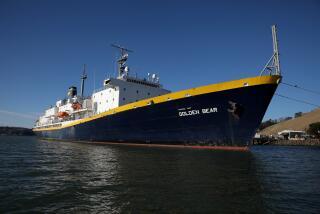Taking a Stand that George Custer Would Understand : Merchant Marine Academies Are Barely Afloat
- Share via
If, without donning scuba gear, you would find out how deep the U.S. merchant marine has sunk into oblivion, consider this:
The actual “love boat” on TV’s “Love Boat” is Norwegian.
Why, then, are one federal and six state maritime academies in the United States still in business when the nation’s merchant ships are barely afloat? Are these young sailors training to man a Titanic?
Good question, difficult answer.
Indeed the schools are in business, albeit with trimmed sails. They turn out about 725 graduates a year, only a minority of whom will actually fill a berth at sea. The rest, like their recent predecessors, will find places with port authorities, shipping and stevedoring firms, the Navy, tugboats, ship designers, marinas, yacht yards, an admiralty law office or two. One is relief captain of the Mississippi excursion stern-wheeler Delta Queen. A few are weathermen.
‘The Last Stand’
“The last stand of the U.S. merchant marine is in these academies,” said Frank Braynard, museum curator of the U.S. Merchant Marine Academy at Kings Point on New York’s Long Island.
A last stand George Custer could commiserate with.
In 1986, goods worth $320.5 billion entered or left the United States by sea. Only 4% of it was in American bottoms. Although more than 90% of the Earth’s trade moves by sea in 25,000 ships, the U.S. merchant fleet numbered just 371 active, oceangoing vessels, 11th worldwide. (Panama was first with 3,278 ships, the Soviet Union second with 2,453.) The last ocean merchant ship built in a U.S. yard, 76 of which have closed since 1980, was launched last year. None is currently building. None is on order.
A presidential commission on the merchant marine and defense headed by former U.S. Sen. Jeremiah Denton of Alabama predicted last December that unless actions are taken the number of ships and seamen will drop by one-half by the year 2000. Rear Adm. Kenneth M. Curtis, president of the Maine Maritime Academy in Castine, cites a Navy estimate of a shortage of 8,100 trained seamen in the military Sea Lift Command alone.
Reason for Survival
To keep that shortfall from getting worse is one reason the academies survive. The United States has about 100 ships mothballed that could be commissioned in five to 10 days in a national emergency. But crews cannot be mothballed to man them.
But should there be World War III and should it be fought like the first two, some see the maritime weakness of the United States as the possible Achilles heel.
“Our merchant fleet bears the heavy onus of being the first of our heavy industries exported overseas,” said Rear Adm. Paul L. Krinsky, superintendent of Kings Point. “But we’re not static. Buggy-whip manufacturers went broke because they thought they were in the buggy-whip business instead of transportation.” Americans are once again pioneering, this time in “intermodalism,” the fine art of combining and coordinating road, rail and air freight for sea transport or vice versa.
Thirty years ago, half of America’s seamen came up “the hawsepipe.” The only requirement for promotion was to pass successive Coast Guard exams at minimum three-year intervals on the ladder from seaman to mate to captain or chief engineer. Today, 17% of licensed officers are graduates of Kings Point alone.
Century-old Idea
The first academy for commercial mariners dates back a century. The progenitor was Adm. Stephen B. Luce, a graduate of the U.S. Naval Academy at Annapolis, where merchant sailors have been mildly deprecated as “the black shoe navy.” Luce proposed that coastal cities set up facilities to train sailors.
In 1874, New York City acquired the old sloop-of-war St. Mary for use as a floating school. It was succeeded by the armed frigate Newport, which was towed around the harbor with faculty and students to wherever the cheapest berth could be found.
In the 1930s, President Franklin D. Roosevelt, a former navy man, eyed Ft. Schuyler at the Bronx entrance to the East River as a site for a permanent land school. The fort, which had never fired a shot and whose only scar was a bar sawed out by a prisoner escaping from the brig, was also eyed by New York’s road-park-bridge visionary, Robert Moses.
“It would make a fine park,” said Moses.
“A fine school,” said the President. So the New York Maritime Academy moved in among the cannons and abides, now a part of the State University of New York and named SUNY Maritime College.
Cause for Embarrassment
Meanwhile, Roosevelt saw the need for a federal counterpart, a complement to Annapolis, West Point and the Coast Guard Academy. The U.S. merchant marine had been embarrassed in 1934 by the burning of the Morro Castle off the New Jersey coast, which took 125 lives. Some officers abandoned ship before the passengers. Fire hoses didn’t fit. Professionalism was needed. And there was war in the air. To Roosevelt, the merchant marine was the fourth arm of the military.
The Merchant Marine Act of 1936 thereupon created a national maritime academy. Two years later the first corps assembled. Coast Guard bases and even Ft. Schuyler were used until a permanent home was found in Walter Chrysler’s former summer home at Kings Point on Long Island, across the Sound from Ft. Schuyler.
In 1948, Kings Point converted to a four-year bachelor of science program. Today students take courses to be deck officers or engineers with additional training in management, logistics, some humanities--and swimming, a requirement. They are appointed by congressmen, as at other service academies. In exchange for a free education they must maintain a mariner’s license for 10 years, serve in the Naval Reserve for eight and work in the maritime industry ashore or at sea.
Some Go to Sea
Of last June’s 213 graduates (17 of whom were women, eight of those engineers), 28 entered the military, about the recent average.
Thirty percent of the class of ’87 found slots at sea, 45% jobs ashore, 20% joined the military and 5% went on to graduate school. All students receive a year’s training aboard a U.S. flag merchantman.
SUNY Maritime College, on the other hand, sends its 750 students out for two months every summer aboard the Empire State, the former passenger liner of President Jackson. They do everything--including navigation, running the engines and chipping paint.
“The advantage of our system over Kings Point is that our students run the ship under supervision. They are at the mercy of whatever captain they serve under as to how much they are taught,” said Dr. William Porter, the academy’s vice president.
SUNY grads must also be able to tie 21 knots, which most put off learning until the last minute, unaware that a horny-handed bosun will time them with a stopwatch. They have to swim too.
Surviving in Dry Times
“Our kids have more flexibility than Kings Point,” said Bob Hogg, SUNY director for community affairs. “Kings Pointers have their service commitment. Ours in dry times can go to places like Consolidated Edison if they are engineers. A marine architect can go into an architectural firm. We can also take older students, foreigners and those who can’t pass the Kings Point physical.”
With the prevalence of union requirements, it is a rare sailor these days who becomes an officer up the hawsepipe. “And probably only a foolhardy one even tries,” Porter said.
“Few seek out the academies because of the romance of the sea,” Krinksy said. Quickly loaded containers have done away with languorous or lascivious days in port. Students come for technical training or because friends or family came before.
“They are middle-class, achievement-oriented kids who have been encouraged by parents and teachers,” Krinsky said. “Their SATs aren’t Harvard-Yale, but their achievement is comparable after graduation.” Kings Point alumni are a who’s who of leaders in the maritime world.
“Kings Point’s focus is more narrow than ours,” said Hogg, whose school offers so many courses that students, uniformed as are those at Kings Point and other academies, can’t march to class. “They are training future officers. Ours get that training, plus.”
Still in Maritime Field
Twenty-five years out, just over half of the Kings Point grads are still in the maritime field, a slightly better record than the other service academies. Sixty percent of the Ft. Schuyler graduates go into the maritime business and the rest into allied occupations. One, Gary Jobson, was tactician on an America’s Cup defender. Ft. Schuyler has benefited handsomely by being official sponsor of several Cup yachts, which it gets to sell when the races are over.
Besides the school in Maine, there are maritime academies in Massachusetts, Texas, California and Michigan, all state-run. “And all of them,” said Porter, “are concerned with dwindling enrollments.”
A forthright commencement speaker at any of the academies would warn that the sea, American-style, is not an encouraging field. There are billets for only 4,116 deck and engineering officers on U.S. flag vessels.
“In 1980, 80% of the graduates of maritime academies found shipboard positions,” said Eugene Rose, president of Seatrain Lines. “This number was reduced to about 25% last year.”
To share the work available, unions rotate jobs so that some mariners are at sea only four months a year.
Problems Dockside
For years, neglect, vacillating policies, greed and crime have beset the U.S. merchant fleet. Dockside theft was so bad in New York that one shoe company sent the lefts in one shipment and the rights in another to frustrate two-legged looters.
The unions, once a favorite whipping boy to blame for the high costs of U.S. shipping, “are ready for an agreement with anyone,” Braynard said. “It’s very hard to say they are to blame. When they were riding high, they rode high. But they were no more lousy when they had power than the shipowners when they did. It’s a human-nature situation.”
Human nature, however, has not launched ships since Helen of Troy. Economics does. And military need. Here again it’s an Alice in Wonderland world. The United States does have a respectable container fleet. But you can’t fit a tank in a box. Container ships need dockside cranes. You don’t find those on invasion beaches.
To qualify for the $250 million in operating subsidies Uncle Sam pays American shipping a year, the ships must be built in American yards. But, as the Denton commission noted, American yards are a highly endangered species, even for military vessels. A South Korean yard can build a ship for a third of what an American yard would charge. Several years ago Congress recognized this by “opening a window” to let U.S. companies build overseas. Then it closed the window. At the same time, U.S. carriers are required to replace their fleets periodically to qualify for subsidies.
Appears Rudderless to Some
In such logical whirlpools the American merchant marine spins rudderless, to some observers.
“I don’t think we can be totally dependent on the rest of the world,” Krinsky said. “Who would ever, say, let foreign airlines on our domestic routes? Or foreign railroads? But shipping. . . ?”
In step with Reaganomics, Kings Point has cut back enrollment 25% over the last five years. If the merchant marine were simply a commercial industry, this might be a resigned acknowledgement of the practicalities. If, on the other hand, the merchant marine is indeed an arm of the military, shouldn’t this be as alarming as the scuttling of every fourth aircraft carrier? To the staffs of the maritime academies, it is.
More to Read
Sign up for The Wild
We’ll help you find the best places to hike, bike and run, as well as the perfect silent spots for meditation and yoga.
You may occasionally receive promotional content from the Los Angeles Times.






